History of Parley Parker Pratt
By Marie Dean Speakman
[Also, please see The Autobiography of Parley P. Pratt]
Ancestry and Early Life
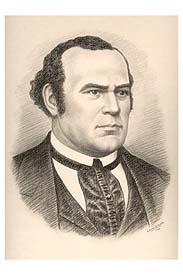 Parley
Parker Pratt was born April 12, 1807 in Burlington, Otsego County, New York
He was the third son of Jared and Charity Pratt. Jared was the son of Obadiah
and Jemima Pratt; Obadiah was the son of Christopher and Sarah Pratt; Christopher
was the son of William and Hannah Pratt; William was the son of Joseph Pratt;
Joseph was the son of Lieutenant William and Elizabeth Pratt, who were found
among the first settlers of Hartford, Connecticut, in the year 1639. They are
supposed to have accompanied the Rev. Thomas Hooker and his congregation, about
one hundred in number, from Newtown, now called Cambridge, Massachusetts, through
a dense wilderness, inhabited only by savages and wild beasts, and became the
first founders of the colony at Hartford, in June 1636. This ancient pilgrim,
William Pratt, was a member of the legislature for some twenty-five or thirty
sessions; and the general court gave him one hundred acres of land in Saybrook,
Connecticut, for service performed as lieutenant in the Pequot War; he was one
of the judges of the first court in New London County.
Parley
Parker Pratt was born April 12, 1807 in Burlington, Otsego County, New York
He was the third son of Jared and Charity Pratt. Jared was the son of Obadiah
and Jemima Pratt; Obadiah was the son of Christopher and Sarah Pratt; Christopher
was the son of William and Hannah Pratt; William was the son of Joseph Pratt;
Joseph was the son of Lieutenant William and Elizabeth Pratt, who were found
among the first settlers of Hartford, Connecticut, in the year 1639. They are
supposed to have accompanied the Rev. Thomas Hooker and his congregation, about
one hundred in number, from Newtown, now called Cambridge, Massachusetts, through
a dense wilderness, inhabited only by savages and wild beasts, and became the
first founders of the colony at Hartford, in June 1636. This ancient pilgrim,
William Pratt, was a member of the legislature for some twenty-five or thirty
sessions; and the general court gave him one hundred acres of land in Saybrook,
Connecticut, for service performed as lieutenant in the Pequot War; he was one
of the judges of the first court in New London County.
Parley P. Pratt’s father, Jared Pratt, son of Obadiah and Jemima Pratt, was born 25 November 1769, in Canaan, Columbia County, New York He first married Mary Carpenter, daughter of Samuel Carpenter, of New Lebanon, New York. She bore him one daughter, named Mary, and afterwards died.
Jared afterwards married Charity Dickinson, daughter of Samuel Dickinson, of Bolton, New York. Charity was born 14 February 1776. They had five children: Anson, born 9 January 1801, died 26 May 1849; William D., born 3 Sept. 1802, died 15 Sept. 1870; Parley P., born 12 April 1807, died 13 May 1857; Orson, born 19 Sept.1811; and Nelson, born 26 May 1815.
Jared Pratt died at Detroit, Michigan, of a fever, 5 November 1839. Charity died at St. Joseph, Missouri of cholera, 20 May 1849.
Parley P. Pratt, because of adverse circumstances, had an extremely limited education, yet displayed, even in youth, an originality of mind seldom exhibited.
Conversion & Missionary Experiences
In September, 1830, being led by the Spirit of the Lord from his home in the state of Ohio, he came several hundred miles eastward where he fortunately obtained a copy of the Book of Mormon. He read the book and was convinced of its divine authenticity, and traveled in search of the highly favored men of God who had seen angels and heard the voice of the Almighty. He soon succeeded in finding some of them, from whom he learned that, about five months previous, the Church of Jesus Christ of Latter-day Saints had been organized. He requested baptism, and was immediately after ordained an Elder. He then visited Canaan, Columbia County, N.Y, where he had spent many of his youthful days, where he preached a few times in different neighborhoods, and baptized his brother, Orson Pratt. He then returned to Seneca County.
Receiving a revelation through Joseph the Prophet, he, in company with three or four others, performed a mission some fifteen hundred miles to the western boundaries of the state of Missouri, and was among the first of the Saints to stand upon that choice land where the city of Zion is hereafter to be built. In the spring of 1831 he returned to the northern part of Ohio where, on June 6, 1831, he was ordained a High Priest by Joseph the Prophet. In the summer he again performed a mission through Ohio, Indiana, Illinois, and Missouri, preaching, baptizing and building up the Church.
In the autumn of 1833, his family along with about twelve hundred men, women, and children where driven by a furious mob from their homes and lands in Jackson County. Missouri. Two hundred houses were burned, cattle shot, haystacks and grain burned, many whipped and others killed, and the afflicted remnant driven across the river into Clay County. Soon after this, Parley traveled about fifteen hundred miles east, preaching repentance and strengthening the Saints. In 1834 he again returned to Clay County, Missouri, officiating in his holy calling wherever he went.
Parley
was chosen and ordained one of the Twelve Apostles of this last dispensation
21 February 1835 by Joseph Smith. The same year he 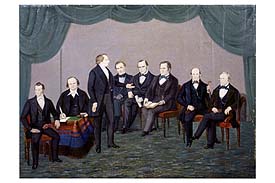 performed
a lengthy missionary journey through Pennsylvania, New York, and several of
the New England States. In 1836 he visited Canada, and established a large branch
of the Church in Toronto, and other branches in adjoining towns. In 1837 he
founded a large branch of the Church in New York City.
performed
a lengthy missionary journey through Pennsylvania, New York, and several of
the New England States. In 1836 he visited Canada, and established a large branch
of the Church in Toronto, and other branches in adjoining towns. In 1837 he
founded a large branch of the Church in New York City.
In 1838 he removed to Caldwell County, near the western boundary of Missouri, where another dreadful persecution commenced against the Saints, and they were again driven from their own houses and their properties were destroyed. Scores of defenseless men, women and children were murdered, and scores of others were incarcerated in dungeons, among whom was Parley P. Pratt and his family. The balance, about fifteen thousand, were exterminated from the state and found refuge in Illinois.
Parley was kept in prison without trial about eight months, when, by the providence of God, he made his escape on 4 July 1839. Immediately after his escape, he published a history of the Missouri persecutions, written while in prison.
In company with others of the Twelve, he went to England in 1840, and in the city of Manchester commenced the publication of a periodical entitled the Millennial Star. In 1841 he was appointed president over all the British conferences, and remained there until the autumn of 1842. The following winter he returned to Illinois, where he continued laboring in the ministry for one or two years.
In 1845 he was appointed president over all the branches in the New England and Middle States, his headquarters being at New York City. In the summer he returned to Nauvoo, but in February 1846, he was again driven from his home by a ruthless mob. After wading through unparalleled sufferings with his family, he and the persecuted Saints succeeded in reaching the Indian country at Council Bluffs, where he was called to go to England. He left his family upon the broad prairies, without house or scarcely any food, to comply with the word of the Lord. He arrived in England, assisted in setting the Church in order, and In strengthening the Saints throughout the British Isles.
In the spring of 1847 he returned to his family and brethren; and in the summer and autumn of that year, he removed to Great Salt Lake Valley, and he and his family suffered incredible hardships until the harvest of 1848.
He assisted in forming a constitution for the provisional government of Deseret, was elected a member of the senate in the general assembly; and to the legislative council when Utah became a territory of the United States.
In 1851 he was sent on a mission to the Pacific Islands and to South America. In the summer of 1855, he returned over the Sierra Nevada Mountains to his home, and spent part of his time preaching in the various settlements of Utah, and labored with his own hands in the cultivation of his farm. In the winter of 1855, he officiated as chaplain in the legislative council at the State House in Fillmore City. In the autumn of 1856, he accompanied about twenty missionaries across the plains to the States. During the winter and part of the following spring he visited the Saints at St. Louis, Philadelphia, New York and other places, preaching, writing and publishing the glad tidings of the Kingdom of God.
Marriages and Family Life
His First Wife:
On the 9th of September, 1827, Parley P. Pratt and Thankful Halsey (born 18 March, 1797) were solemnly united in the bonds of matrimony by Elder Palmer, minister of the Baptist Church, in Canaan, Columbia County, New York. They moved to Ohio to live on land Parley had purchased and cleared and built a log dwelling. During the years that followed their marriage, Thankful’s health was greatly impaired by the first inroads of tuberculosis. She was a courageous, loyal wife, who waited at home while her husband went on one mission after another.
In April 1836, Parley, now a member of the Twelve Apostles, wondered how he could leave his invalid wife again to go on a mission, and he was greatly in debt also. Elder Heber C. Kimball came to their home, filled with the spirit of prophecy, and he made this amazing promise: “Brother Parley, thy wife shall be healed from this hour, and shall bear a son, and his name shall be Parley, and he shall be a chosen instrument in the hands of the Lord to inherit the priesthood and walk in the steps of his father. He shall do a great work in the earth in ministering the Word and teaching the children of men. Arise, therefore, and go forth in the ministry, nothing doubting, for the Lord will supply you with abundant means for all things.”
Parley was told that there was an important mission for him to perform in Upper Canada, where he would find a people prepared for the fullness of the gospel. It was a marvelous prophecy, for during almost six years of her childless marriage. Thankful had been considered an incurable consumptive. Parley soon left for his mission and when he returned to Kirtland on business two months later, he found his wife entirely healed from her long illness. She was well enough go to Canada with Parley and share the missionary experience with him. Parley completed a very successful mission as the prophecy had foretold.
On March 25, 1837, less than a year after Brother Kimball uttered his inspired prophecy, a son was born to Parley and Thankful, whom they named Parley P., Jr. The prophecy had been literally fulfilled, but when Thankful had completed her part in bringing about the fulfillment, her earthly mission was finished. No sooner had her son been given to her for one motherly caress than she quietly passed on to the paradise of rest. Her death, at the age of forty, brought overwhelming grief to Parley, which he found no words to express. But in his longing for Thankful, he found consolation in the precious life of their son, their child of promise. Thankful Pratt was buried in the churchyard near the temple in Kirtland, Ohio.
His Second Wife:
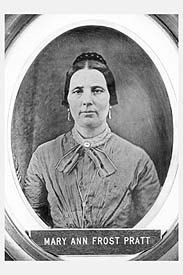 Mary
Ann Frost was born in Bethel, Maine, January 14, 1809, to Aaron Frost and Susan
Gray. She married Nathan Stearns and had one daughter, Mary Ann, born April
6, 1833. When Mary Ann was only five months old, her father died. Mary Ann Frost
Stearns and her mother, Susan Gray Frost heard the gospel and were baptized
by Apostle David W. Patten. They gathered, with other converts, to Kirtland,
Ohio. Here, on May 9, 1837, Mary Ann Frost Stearns married Elder Parley P. Pratt.
In 1840 his family accompanied him on a mission to England.
Mary
Ann Frost was born in Bethel, Maine, January 14, 1809, to Aaron Frost and Susan
Gray. She married Nathan Stearns and had one daughter, Mary Ann, born April
6, 1833. When Mary Ann was only five months old, her father died. Mary Ann Frost
Stearns and her mother, Susan Gray Frost heard the gospel and were baptized
by Apostle David W. Patten. They gathered, with other converts, to Kirtland,
Ohio. Here, on May 9, 1837, Mary Ann Frost Stearns married Elder Parley P. Pratt.
In 1840 his family accompanied him on a mission to England.
Parley and Mary Ann had four children: Nathan, born 31 Aug. 1838; Olivia, born 02 June 1841; Susan, born 7 April 1843; and Moroni, born 7 December, 1844. Nathan died in 1843 and Susan in 1844, but Olivia and Moroni accompanied their mother, Mary Ann, across the plains. After an eventful trip, they arrived in the valley in August 1852.
Parley P. Pratt, returning from his second mission to the Pacific, wrote: “On my arrival home, I found my wife, Mary Ann Frost, and my two children, Olivia and Moroni, who had arrived from Maine, her former home, where they had been for several years. The two children were glad to see me, but their mother had for several years been alienated from me. I however, supported her until the following spring, when she applied for and obtained a bill of divorce; after which, with the two children, she removed to Utah County.”
Mary Ann died March 27, 1913, and was buried in Pleasant Grove, Utah.
His Third Wife:
Elizabeth Brotherton was born March 27, 1816 in Manchester, England, to Thomas and Sarah Hamilton Brotherton. She joined the L.D.S. Church in 1840, and came to Nauvoo in 1841. In 1843 she was married to Parley Pratt in Nauvoo by Patriarch Hyrum Smith. She came to Utah in 1847, arriving in September 1847.
Elizabeth was an active, faithful member of the Church, and was a member of the first Relief Society organized in Utah. At the time of her death, May 9, 1897. She was living in the Twenty-second Ward in Salt Lake. They had no children.
His Fourth Wife:
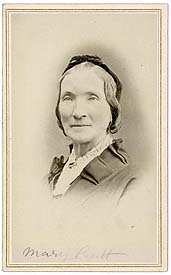 Mary
Wood, daughter of Samuel and Margaret Orr Wood, was born 18 June 1818 in Glasgow
Scotland. She was well-educated for that period, and was an accomplished seamstress.
She was residing in Liverpool, England, when she came in contact with the Latter-day
Saint missionaries, and was baptized March 29, 1839 in the Manchester Branch.
Mary
Wood, daughter of Samuel and Margaret Orr Wood, was born 18 June 1818 in Glasgow
Scotland. She was well-educated for that period, and was an accomplished seamstress.
She was residing in Liverpool, England, when she came in contact with the Latter-day
Saint missionaries, and was baptized March 29, 1839 in the Manchester Branch.
In 1841, Parley P. Pratt was chosen to preside over the British Mission. Mary was an ardent member of the Manchester Branch. After his family returned to Nauvoo (this was the mission where his wife, Mary Ann Frost Pratt, and his children accompanied him} he wrote to Mary Wood and encouraged her to come to Zion. He told her that Mrs. Pratt (Mary Ann) wanted her to live with them in an upper room to follow her trade as a seamstress and milliner, which should be good in Nauvoo.
Mary did come to America and to Nauvoo, March 1, 1844, and on September 9, 1844, she became a plural wife of Parley P. Pratt. She endured the hardships and persecutions with the Saints in the mobbings and slaying of their Prophet and Patriarch. She was among the first to leave her home in that historic February of 1846. Helaman, the first child of Parley and Mary was born on May 31, 1846, on the way to Winter Quarters. They reached the Great Salt Lake Valley September 19, 1847.
Parley and Mary had four children: Helaman, born 31 May 1846; Cornelia, born 5 Sept. 1848; Mary, born 14 Sept. 1853; and Mathoni, born 6 July 1856. After the tragic death of her husband, Mary took over the full responsibility of rearing her four small children, the oldest being only ten years of age. In her young widowhood, she received many proposals of marriage from prominent men, but always the face of Parley came to her and she could see no other. She reared her two sons and two daughters, saw them all married in the temple and all active, energetic church workers. Mary died March 5, 1898 in Salt Lake City.
His Fifth Wife:
Hannahette Snively, daughter of Henry Snively and Mary Heavnor, was born October 22, 1812, at Woodstock, Shenandoah County, Virginia. Hannahette and her sisters, Susan and Mary, were converted to the L.D.S. Church by Erastus Snow. With money given them from their father’s estate, Hannahette and Susan built a brick home in Nauvoo. Hannahette married Parley P. Pratt November 2, 1844, in the Nauvoo Temple. They were married by Brigham Young.
Hannahette had a sunny disposition, and was never one to brood or complain over any of the hardships or troubles incident to pioneer life. She went through the winter of 1846-47 at Winter Quarters and arrived in Salt Lake Valley with the second wagon train September 25, 1847.
Parley and Hannahette had three children: Alma, born 3 July 1845; Lucy, born 9 March 1848; and Henrietta, born 26 October 1851. Hannahette died 21 February 1898 in Salt Lake City.
His Sixth Wife:
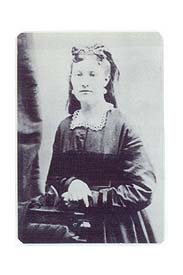 Belinda
Marden was born in Chichester, Merrimack County. New Hampshire, on December
24, 1820, the seventh daughter and the fourteenth child of John and Rachel Shaw
Marden. When Belinda was nineteen, she married Benjamin Abbot Hilton. They were
living in Boston, Massachusetts when, in 1843, they saw a handbill stating that
a Mormon preacher was holding meetings in Roylston Hall. Belinda received an
overwhelming testimony, but her husband didn’t at first, but in the spring
he decided he wanted to be baptized, and they were. It was not long before her
husband apostatized and forbade her to attend also. A year later she left her
husband and was able to go to Nauvoo.
Belinda
Marden was born in Chichester, Merrimack County. New Hampshire, on December
24, 1820, the seventh daughter and the fourteenth child of John and Rachel Shaw
Marden. When Belinda was nineteen, she married Benjamin Abbot Hilton. They were
living in Boston, Massachusetts when, in 1843, they saw a handbill stating that
a Mormon preacher was holding meetings in Roylston Hall. Belinda received an
overwhelming testimony, but her husband didn’t at first, but in the spring
he decided he wanted to be baptized, and they were. It was not long before her
husband apostatized and forbade her to attend also. A year later she left her
husband and was able to go to Nauvoo.
In Nauvoo, after President Young talked to her about Celestial Marriage she said, “I testify that the Holy Spirit of God rested down upon me and it was made plain to my understanding that it was a divine principle and with great joy of heart I accepted it, and never from that time to this, 1889, has there been doubt in my mind concerning it.”
Belinda married Parley P. Pratt November 20. 1844 at the home of Erastus Snow. They were sealed in the Nauvoo temple in December of 1845.
Because of intense persecution of the Saints they were forced to leave their homes and on February 14th. 1846, crossed the Mississippi River. Belinda’s first child, Nephi, born January 1, 1846, was only six weeks old and it was extremely cold. It was a terrible journey to the Missouri River—storming snow and rain almost continually—and they could travel but a few miles each day. They reached the Missouri River in July, near Council Bluffs, and camped there several weeks. “Bro. Pratt left his families there and answered a call to go on a short mission to England. How he hated to leave us there and the suffering we all went through for the gospel’s sake will only be known by those who experienced them. He returned from his mission on April 8, 1847 and immediately began to prepare for journeying to the mountains with his family.” They arrived in the valley of Great Salt Lake in September 1847.
Parley and Belinda had five children: Nephi, born 1 Jan. 1846; Belinda and Abinadi (twins), born 8 May 1848; Lehi, born 9 June, 1851; and Isabella, born 1 Sept 1854.
After the tragic death of Parley, Belinda provided for her little children by teaching school, making dresses and taking in boarders. She moved to Fillmore in 1870. She was always faithful in the Church. She died February 19, 1894.
His Seventh Wife
Sarah Huston was born August 3, 1823. in Starke County, Ohio. She married Parley P. Pratt October 15, 1845 at Nauvoo.
Sarah was a strong and noble character, with a kindly disposition and always optimistic. With other members of the family, she went on the long and tedious journey to Utah. The Elders promised Sarah that she and her family would reach Zion in safety. At one time there was a stampede of oxen and the wagon in which she and her baby daughter, Julia, were riding was overturned. The baby was thrown out among the provisions and other supplies and later found unharmed between two sacks of flour. The promise made by the Elders was fulfilled.
Parley and Sarah were the parents of four children: Julia, born 01 April 1847; Mormon, born 08 January 1850; Teancum, born 15 November 1851; and Sarah, born 31 May 1856.
After the death of Parley, Sarah married A. Lewis Taufig. Sarah went to Southern Utah to be near her family. She was in every way a loyal pioneer. She died May 26, 1886, at Coyote (later called Antimony), Garfield County, Utah.
His Eighth Wife:
Phoebe Soper was born at Hempstead Harbor, Queen’s County, Long Island, New York, July 8, 1823. She became converted to Mormonism and moved to Nauvoo in February 1846. She married Parley Parker Pratt February 8, 1846, and “on the 13th of February I took my departure and left Nauvoo in company with my husband and family, the rest of the twelve that were present and as many as could get ready. In poverty we left Nauvoo but cheerfulness seemed to power nearly every heart. I am blest with a husband of noble and generous turn of mind and affectionate heart, one that delights in good acts and kindness and discharging every known duty. I have one of the best men that ever graced this earth or ever will in my humble opinion.” Phoebe had crossed the plains with her husband, Parley Pratt, in the second company of pioneers, and arrived in Great Salt Lake City in September 1847.
In 1851, Phoebe accompanied Parley on his mission to San Francisco and later to Guillotte, Chile.
Phoebe and Parley were the parents of three children: Mosiah, born 26 February 1850; Omner, born 30 November 1851; and Phoebe, born 19 May 1853. After the death of her husband, Phoebe married W. S. Holdaway and lived in Provo. She remained a faithful Latter-day Saint until her death September 11, 1887.
His Ninth Wife:
Martha Monk was born April 28, 1825, in Raynor, Chestershire, England, the daughter of Thomas and Sarah Monk. She accepted the gospel as taught by Mormon elders, became the wife of Apostle Parley P. Pratt in 1847, and came to Utah the same year with the family. Her first home in Salt Lake Valley was in the Fort where on January 30, 1849, she gave birth to her first child whom they named Ether. She was deeply hurt when, on February 22, the child died and was buried in or near the Fort. Martha later was separated from Apostle Pratt and soon afterward left for California where she died.
His Tenth Wife:
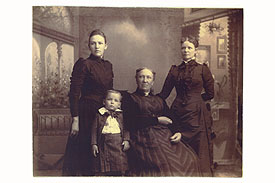 Ann
Agatha Walker was born at Leek, Staffordshire, England, June 11, 1829. Her parents
were William Gibson Walker, a schoolteacher, and Mary Goodwin, the town milliner.
She was the eldest of six children.
Ann
Agatha Walker was born at Leek, Staffordshire, England, June 11, 1829. Her parents
were William Gibson Walker, a schoolteacher, and Mary Goodwin, the town milliner.
She was the eldest of six children.
When Ann Agatha was eight years old, the new gospel was brought to England. The Walker family were members of the Wesleyan Methodist Church. The family moved to Pendleton where they first heard the gospel of Jesus Christ of Latter-day Saints. William held an office in his church and was a local preacher. They became interested in the Mormon Church and the family was all baptized except their daughter, Dorcas.
The family all desired to come to Zion and join the Saints, and when Elders Parley P. Pratt and John Taylor completed their mission, Am Agatha was the one from her family to return with them to America. She was seventeen at this time.
Ann Agatha married Parley P. Pratt on April 28, 1847 at Winter Quarters. They arrived in the Valley September 28, 1847.
They became the parents of five children: Agatha, born 7 July 1848; Malona, born 15 April 1850; Marion, born 28 November 1851; Moroni, born 10 October 1853; and Eveline, born 8 August 1856.
Parley was killed 13 May 1857, while serving on a mission, and Ann Agatha was only twenty-eight years old and left with four young children. Three years later she was asked by Joseph Harris Ridges, builder of the Tabernacle Organ, to be his wife. By counsel of President Brigham Young, she was married for time to Mr. Ridges March 4, 1860. Two children were born to them. Six years after this marriage, January 20, 1866, Joseph Ridges took for his fourth wife, Agatha Pratt, daughter of Ann Agatha and Parley P. Pratt. About this time Ann Agatha discontinued living with Joseph Ridges, although there is no record of a divorce.
Am Agatha was an ardent church worker with a strong testimony of the gospeL She died in her home in Ogden, Utah on June 25, 1908 at age 79.
His Eleventh Wife
Kezia Downs was born May 10,1812 at Raynor, Chestershire, England. She was baptized by Elder Parley P. Pratt and arrived in the Salt Lake Valley in 1851. December 17, 1853, she was married to Elder Pratt. In his autobiography he says: While at home my time was occupied in attending meetings, instructing and speaking words of comfort and encouragement to the Saints, and writing my history, assisted by my wife Kezia, as copyist.
Kezia died at her residence in the 14th Ward of consumption and dropsy, January 11, 1877, a much-esteemed woman and firm in the faith of the gospel.
His Twelfth Wife:
Elenor J. McComb was born December 29. 1817 in Wheeling, West Virginia, the daughter of James McComb. Elenor married Hector McLean and they went to San Francisco, where she became acquainted with the Mormon elders and was later baptized. Elenor was the mother of three children, a girl and two boys. Her sons were baptized, but Mr. McLean did not accept Mormonism and did not want his children to belong to the Mormon Church, so he sent them around the Horn to New Orleans to be cared for by Elenor McLean’s parents.
Elenor became acquainted with Parley P. Pratt on one of his missions and divorced her husband, then came to Utah where she was married to Apostle Pratt November 14, 1855, in Salt Lake City. Hearing that her children were in her father’s home, she made plans to go to New Orleans and gain possession of them. Elder Pratt was called on a mission and she accompanied him and immediately went to her father’s house where she was united with her children.
Following the assassination of her husband, Parley Pratt, by her former husband, Hector McLean, Elenor returned to Salt Lake City, where it is said she taught school, including one in the Brigham Young schoolhouse. She died 24 October 1874 in Salt Lake City.
His Last Mission and Assassination
Ann Agatha Walker Pratt told of Parley coming to tell her that he had been called on another mission (she was recovering from confinement with their youngest child, Eveline). Parley told Agatha that he had a feeling “I shall never come back.” Parley was set apart for his mission by President Brigham Young, Heber C. Kimball, and Jedediah M. Grant (the First Presidency). He attended fast meeting the first Thursday in September, confirmed several of his children whom he had baptized, named and blessed the youngest born, and bore a faithful testimony. He started for his mission about the 14th of September 1856.
The account of the last mission and death of Parley Parker Pratt is taken from the Publisher’s Preface in the Deseret Book 1985 edition of the “Autobiography of Parley P Pratt “. This preface was written by Dr Larry C. Porter Director of Church History; Religious Studies center, Brigham Young University.
After more than twenty-five years of constant missionary labors, Elder Pratt had some personal expectations of remaining closer to home and family for a season. Such imaginations were short-lived. In 1856 President Brigham Young directed him to carry out an extended proselyting tour in the eastern states. In his last discourse to the Saints assembled at the Bowery, Great Salt Lake City, September 7, 1856 he said:
“I am now about to wart to the States, to preach the Gospel of Jesus Christ and bear testimony of those things which I most assuredly do know; for this is my calling. I have desired, after traveling for twenty-five or twenty-six years, mostly abroad, to stay at home and minister among the people of God, and take care of my family: but God’s will be done, and not mine. If it is the will of God that I should spend my days in proclaiming this Gospel and bearing testimony of these things, I shall think myself highly privileged and honored. And when the Spirit of God is upon me, I think it matters but very little what I suffer, what I sacrifice—whether I secure the honor or dishonor of men, or where I die, it so be that I can keep the faith, fight the good fight, and finish my course with joy.”
Leaving Salt Lake City on 11 September 1856, Elder Pratt traveled extensively among the branches in Philadelphia, New York City, Cincinnati, and elsewhere. While he was engaged in that calling, a man by the name of Hector McLean actively began to trace his whereabouts, blaming Elder Pratt for the estrangement between him (McLean) and his former wife, Eleanor. McLean nearly caught him in St. Louis. Fortunately, Elder Pratt eluded the man and managed to escape to Indian Territory (Oklahoma), where Elder George B. Higginson was working among the Indians of the Creek and Cherokee nations. Here Elder Pratt was arrested by a Captain Little of the U.S. Cavalry on a warrant emerging from the charges filed by Hector McLean at Fort Gibson (Oklahoma).
Elder Pratt was transferred under guard to Van Buren, Crawford County, Arkansas, where the nearest federal court convened. Judge John B. Ogden, U.S. Commissioner, presided over the examining session on Tuesday, 12 May 1857. Evidence presented against Elder Pratt was considered sufficient to warrant holding him, and he was acquitted. However, the judge purposely did not announce the decision to release Elder Pratt at that time, hoping to dissuade McLean from his avowed determination to kill him. Elder Pratt was kept at the jailhouse overnight in protective custody. Early the next morning Judge Ogden brought his horse to him at the jail, saw that he was discharged, and at the same time offered him a knife and a pistol as a means of self-defense. But Elder Pratt declined, saying, “Gentlemen, I do not rely on weapons of that kind, my trust is in my God. Goodbye, gentlemen.”
Although Elder Pratt rode a circuitous route to escape his pursuers, a light rain allowed Hector McLean and two accomplices, James Cornell and Amasa Howell, to track him. They caught up with the fleeing man some twelve miles northeast of Van Buren (near Alma, Arkansas) in front of the Winn farm. McLean fired shots, but they failed to take effect. Riding up to Elder Pratt, McLean stabbed him in the left breast with his bowie knife. The wounded man fell from his horse while his assailants rode off. About ten minutes later McLean returned and, placing a gun next to Elder Pratt’s neck, deliberately fired into the prostrate figure. Mr. Winn was a witness to the entire scene. He and some of his neighbors attended to the apostle in his dying moments. Before Elder Pratt died approximately two and a half hours later, he instructed those gathered about him on how to notify his family and the disposition of his personal effects. He then shared his final testimony: “I die a firm believer in the Gospel of Jesus Christ as revealed through the Prophet Joseph Smith, and I wish you to carry this my dying testimony. I know that the Gospel is true and that Joseph Smith was a prophet of the living God, I am dying a martyr to the faith.”
Elder Pratt’s body was “shrouded in fine linen” and placed in a pine casket prepared by William T. Steward. The remains were then driven by John B. Stewart to Sterman’s graveyard (now known as Fine Springs), where Elder George Higginson buried them at about ten o’clock on the evening of Thursday, May 14. 1857.
In the Territory of Utah, Brigham Young declared, concerning Elder Pratt’s death, “Nothing has happened so hard to reconcile my mind to since the death of Joseph.”
Elder John Taylor assisted Parley Parker Pratt’s eldest son. P. P. Pratt, in preparing for publication the history which Parley had written and had charged his son with the responsibility of publishing it in case anything should happen to him. Elder Taylor said: “Brother Parley brought the gospel to and baptized me He was indeed a true Latter-day Saint, an honorable Apostle, a good and kind husband, an affectionate father, a true friend, and an honest man.
“From various premonitions which he had during his last visit with me in New York, I was satisfied that when I took my last, sad leave of him in that city, I should never see his face again in the flesh. These presentiments were but too speedily and sadly fulfilled. He has gone—but has left a name and a fame that will live throughout time and burst forth in eternity; and in the morning of the first resurrection, when the opening heavens shall reveal the Son of God, and he shall proclaim, “I am the resurrection and the life,” when Death shall deliver up the dead, I expect to meet Brother Parley in the resurrection of the just.”
(This history of Parley P. Pratt was compiled by Marie Dean Speakman, March 1997, primarily from Parley P. Pratt and His Twelve Wives", by Kate B. Carter, Daughters of the Utah Pioneers (January 1974), and from the Autobiography of Parley P. Pratt.).
Other Parley P. Pratt links:
Parley P. Pratt page in Mormon Literature & Creative Arts site
A Voice of Warning original edition (1837)